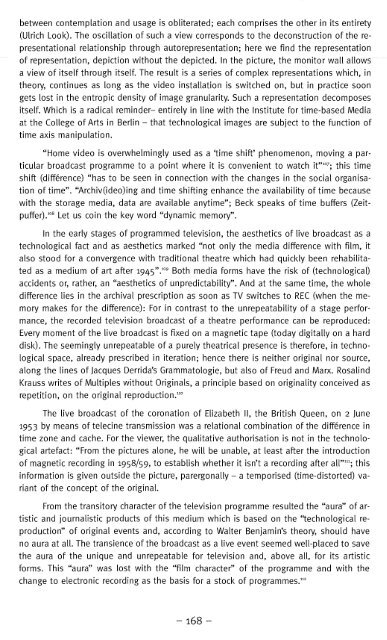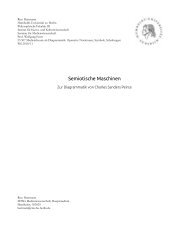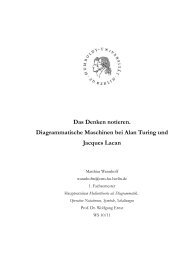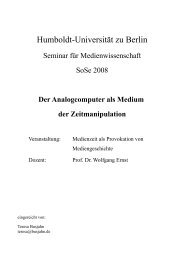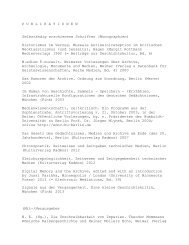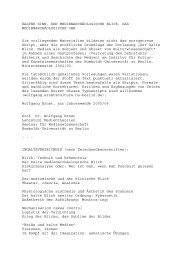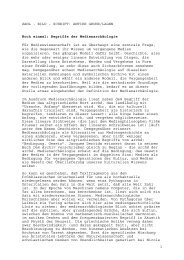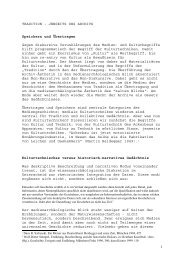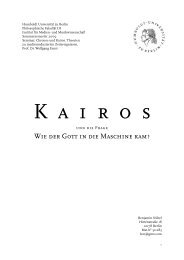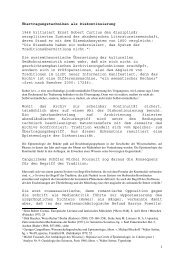Download - Medienwissenschaft
Download - Medienwissenschaft
Download - Medienwissenschaft
You also want an ePaper? Increase the reach of your titles
YUMPU automatically turns print PDFs into web optimized ePapers that Google loves.
etween contemplation and usage is obliterated; each comprises the other in its entirety<br />
(Ulrich Look). The oscillation of such a view corresponds to the deconstruction of the representational<br />
relationship through autorepresentation; here we find the representation<br />
of representation, depiction without the depicted. In the picture, the monitor wall allows<br />
a view of itself through itself. The result is a series of complex representations which, in<br />
theory, continues as long as the video installation is switched on, but in practice soon<br />
gets lost in the entropic density of image granularity. Such a representation decomposes<br />
itself. Which is a radical reminder- entirely in line with the Institute for time-based Media<br />
at the College of Arts in Berlin - that technological images are subject to the function of<br />
time axis manipulation.<br />
"Home video is overwhelmingly used as a 'time shift' phenomenon, moving a particular<br />
broadcast programme to a point where it is convenient to watch it" 107 ; this time<br />
shift (difference) "has to be seen in connection with the changes in the social organisation<br />
of time". "Archiv(ideo)ing and time shifting enhance the availability of time because<br />
with the storage media, data are available anytime"; Beck speaks of time buffers (Zeitpuffer).<br />
108 Let us coin the key word "dynamic memory".<br />
In the early stages of programmed television, the aesthetics of live broadcast as a<br />
technological fact and as aesthetics marked "not only the media difference with film, it<br />
also stood for a convergence with traditional theatre which had quickly been rehabilitated<br />
as a medium of art after 1945". 109 Both media forms have the risk of (technological)<br />
accidents or, rather, an "aesthetics of unpredictability". And at the same time, the whole<br />
difference lies in the archival prescription as soon as TV switches to REC (when the memory<br />
makes for the difference): For in contrast to the unrepeatability of a stage performance,<br />
the recorded television broadcast of a theatre performance can be reproduced:<br />
Every moment of the live broadcast is fixed on a magnetic tape (today digitally on a hard<br />
disk). The seemingly unrepeatable of a purely theatrical presence is therefore, in technological<br />
space, already prescribed in iteration; hence there is neither original nor source,<br />
along the lines of Jacques Derrida's Grammatologie, but also of Freud and Marx. Rosalind<br />
Krauss writes of Multiples without Originals, a principle based on originality conceived as<br />
repetition, on the original reproduction. 110<br />
The live broadcast of the coronation of Elizabeth II, the British Queen, on 2 June<br />
1953 by means of telecine transmission was a relational combination of the difference in<br />
time zone and cache. For the viewer, the qualitative authorisation is not in the technological<br />
artefact: "From the pictures alone, he will be unable, at least after the introduction<br />
of magnetic recording in 1958/59, to establish whether it isn't a recording after all" 111 ; this<br />
information is given outside the picture, parergonally - a temporised (time-distorted) variant<br />
of the concept of the original.<br />
From the transitory character of the television programme resulted the "aura" of artistic<br />
and journalistic products of this medium which is based on the "technological reproduction"<br />
of original events and, according to Walter Benjamin's theory, should have<br />
no aura at all. The transience of the broadcast as a live event seemed well-placed to save<br />
the aura of the unique and unrepeatable for television and, above all, for its artistic<br />
forms. This "aura" was lost with the "film character" of the programme and with the<br />
change to electronic recording as the basis for a stock of programmes. 112<br />
-168-


